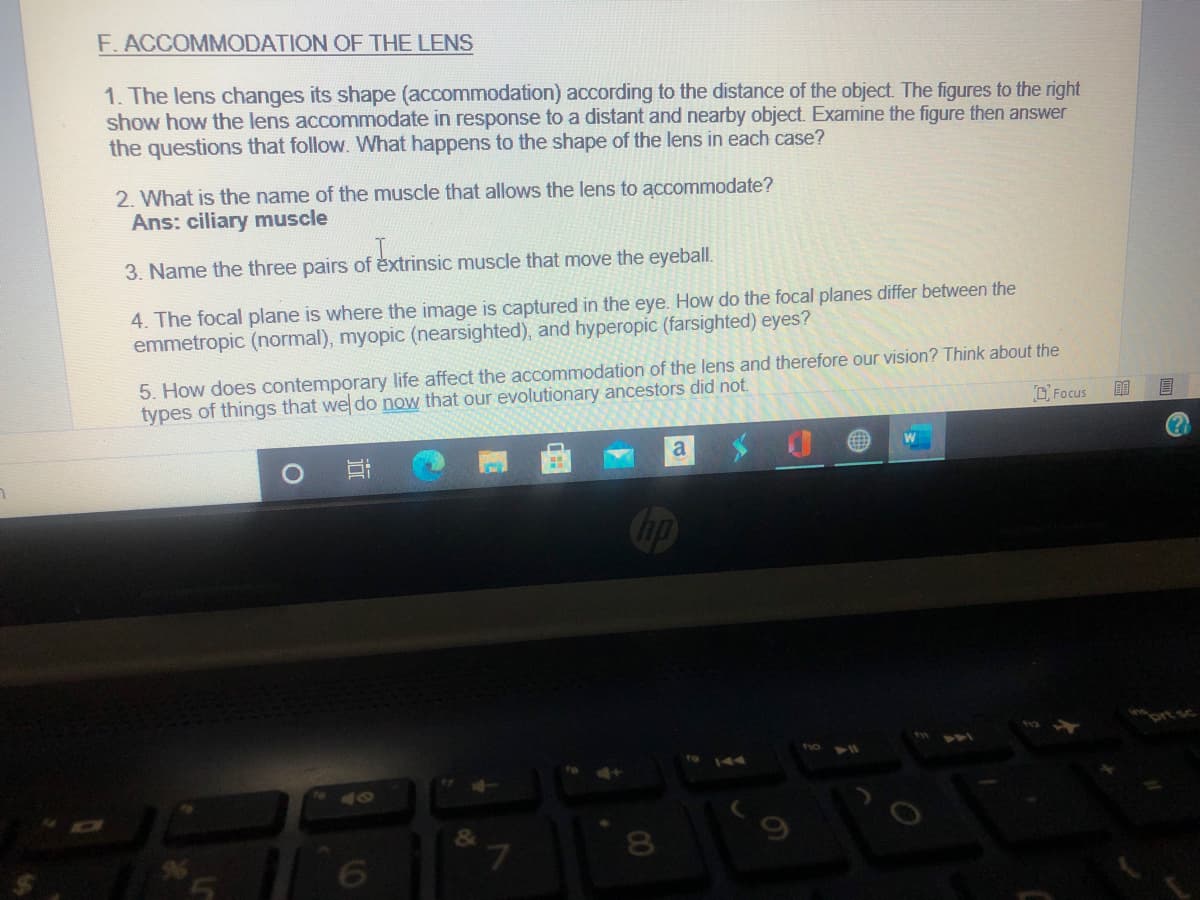F. ACCOMMODATION OF THE LENS 1. The lens changes its shape (accommodation) according to the distance of the object. The figures to the right show how the lens accommodate in response to a distant and nearby object. Examine the figure then answer the questions that follow. What happens to the shape of the lens in each case? 2. What is the name of the muscle that allows the lens to accommodate? Ans: ciliary muscle 3. Name the three pairs of extrinsic muscle that move the eyeball. 4. The focal plane is where the image is captured in the eye. How do the focal planes differ between the emmetropic (normal), myopic (nearsighted), and hyperopic (farsighted) eyes? 5. How does contemporary life affect the accommodation of the lens and therefore our vision? Think about the types of things that we do now that our evolutionary ancestors did not. D Focus
F. ACCOMMODATION OF THE LENS 1. The lens changes its shape (accommodation) according to the distance of the object. The figures to the right show how the lens accommodate in response to a distant and nearby object. Examine the figure then answer the questions that follow. What happens to the shape of the lens in each case? 2. What is the name of the muscle that allows the lens to accommodate? Ans: ciliary muscle 3. Name the three pairs of extrinsic muscle that move the eyeball. 4. The focal plane is where the image is captured in the eye. How do the focal planes differ between the emmetropic (normal), myopic (nearsighted), and hyperopic (farsighted) eyes? 5. How does contemporary life affect the accommodation of the lens and therefore our vision? Think about the types of things that we do now that our evolutionary ancestors did not. D Focus
Human Anatomy & Physiology (11th Edition)
11th Edition
ISBN:9780134580999
Author:Elaine N. Marieb, Katja N. Hoehn
Publisher:Elaine N. Marieb, Katja N. Hoehn
Chapter1: The Human Body: An Orientation
Section: Chapter Questions
Problem 1RQ: The correct sequence of levels forming the structural hierarchy is A. (a) organ, organ system,...
Related questions
Question

Transcribed Image Text:F. ACCOMMODATION OF THE LENS
1. The lens changes its shape (accommodation) according to the distance of the object. The figures to the right
show how the lens accommodate in response to a distant and nearby object. Examine the figure then answer
the questions that follow. What happens to the shape of the lens in each case?
2. What is the name of the muscle that allows the lens to accommodate?
Ans: ciliary muscle
3. Name the three pairs of extrinsic muscle that move the eyeball.
4. The focal plane is where the image is captured in the eye. How do the focal planes differ between the
emmetropic (normal), myopic (nearsighted), and hyperopic (farsighted) eyes?
5. How does contemporary life affect the accommodation of the lens and therefore our vision? Think about the
types of things that we do now that our evolutionary ancestors did not.
DFocus
国
Cop
ho
40
7.
00
(0
Expert Solution
This question has been solved!
Explore an expertly crafted, step-by-step solution for a thorough understanding of key concepts.
This is a popular solution!
Step 1: Accommodation of lens according to distance of object:
VIEWStep 2: Muscle that allows lens accommodation:
VIEWStep 3: Three pair of extrinsic muscle that helps in movement of eyeball:
VIEWStep 4: Focal plane difference between emmetropic, myopic and hyperopic eyes:
VIEWStep 5: Contemporary life effects on accommodation of lens:
VIEWTrending now
This is a popular solution!
Step by step
Solved in 5 steps

Recommended textbooks for you

Human Anatomy & Physiology (11th Edition)
Anatomy and Physiology
ISBN:
9780134580999
Author:
Elaine N. Marieb, Katja N. Hoehn
Publisher:
PEARSON

Anatomy & Physiology
Anatomy and Physiology
ISBN:
9781259398629
Author:
McKinley, Michael P., O'loughlin, Valerie Dean, Bidle, Theresa Stouter
Publisher:
Mcgraw Hill Education,

Human Anatomy
Anatomy and Physiology
ISBN:
9780135168059
Author:
Marieb, Elaine Nicpon, Brady, Patricia, Mallatt, Jon
Publisher:
Pearson Education, Inc.,

Human Anatomy & Physiology (11th Edition)
Anatomy and Physiology
ISBN:
9780134580999
Author:
Elaine N. Marieb, Katja N. Hoehn
Publisher:
PEARSON

Anatomy & Physiology
Anatomy and Physiology
ISBN:
9781259398629
Author:
McKinley, Michael P., O'loughlin, Valerie Dean, Bidle, Theresa Stouter
Publisher:
Mcgraw Hill Education,

Human Anatomy
Anatomy and Physiology
ISBN:
9780135168059
Author:
Marieb, Elaine Nicpon, Brady, Patricia, Mallatt, Jon
Publisher:
Pearson Education, Inc.,

Anatomy & Physiology: An Integrative Approach
Anatomy and Physiology
ISBN:
9780078024283
Author:
Michael McKinley Dr., Valerie O'Loughlin, Theresa Bidle
Publisher:
McGraw-Hill Education

Human Anatomy & Physiology (Marieb, Human Anatomy…
Anatomy and Physiology
ISBN:
9780321927040
Author:
Elaine N. Marieb, Katja Hoehn
Publisher:
PEARSON